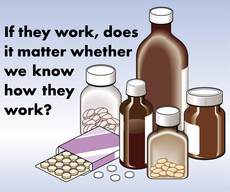Chapter 46 Placebo and nocebo effects
A remedy without any direct action on a disease, given to keep the patient happy, or to persuade the prescriber that he is doing something positive and useful, or both
The emergence of placebo effects
Until recently there could be no neat distinction between drugs whose mode of action for a specific disorder was known and understood, and any other drug (Fig. 1). With the development of scientific medicine, people then began to identify active ingredients and to become more suspicious of drugs whose action was not understood. This introduced the notion that there were drugs that would treat a particular condition by a particular route and other substances that might be placebos.










